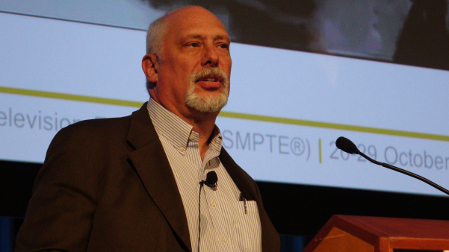Q&A: Jim DeFilippis on 4K, UHD, HDR and More

LAS VEGAS—The video industry is moving into more—more resolutions, more color, more contrast, more frames. Ultra high-def 4KTVs are the new HD. More and more sets feature high dynamic range. Wide color gamut is on the way. The questions now revolve around the workflow—achieving these dynamics glass-to-glass—whether or not it’s worth it, and if so, what’s the best approach.
That’s what four top broadcast engineers take on during the NAB Show in a Tuesday, April 19 at 2:30 p.m. Super Session entitled, “4K, UHD, HDR and More—The Future of Video.” TV Technology’s Deborah D. McAdams will grill video expert Mark Schubin, SMPTE President and CBS Vice President of Engineering and Advanced Technology Robert Seidel, broadcast veteran Jim DeFilippis and Ericsson’s Senior Vice President of Technology for TV & Media Matthew Goldman with crowd-sourced questions from their peers.
Here, Jim DeFilippis takes a crack at the list.
CROWD MEMBER: What provides the best bang for the buck: 2160p resolution, high dynamic, wide color gamut, or high frame rate (120 fps)?
DeFILIPPIS: Good and interesting content! Ok, each provide a unique ability to capture and display content.
CM:The Canadians are now doing baseball, basketball and hockey in 4K, and distributing it via cable. What is holding up the U.S. broadcasters? What are their immediate challenges?
DeFILIPPIS: The difference is that this is one cable/broadcaster (Rogers Communications). DirecTV and Comcast have committed to delivering 4K (Masters Golf, Rio Olypmics).
CM:What about standards? What’s needed?
DeFILIPPIS: We have many standards, but what we are missing is clarity of the problem they are supposed to solve.
CM: Beyond sports, what other genre will benefit and have a business ROI?
DeFILIPPIS:Cinema, perhaps documentaries.
CM:Will broadcasters be “forced” into 4K/UHDTV adoption similar to the evolution of HDTV? If so, by when?
DeFILIPPIS: Different situation today. Back then, with government and private cooperation, the spectrum sell-off traded the mandatory digital tuners. This time around, government is taking spectrum and providing a one-time payout or compensation for re-location to the under-500 MHz ghetto. No mandate to update the digital tuners nor upgrade of the broadcast technology.
CM:What are the key dominos in the chain that need to be knocked over for the consumers to feel this is real and start spending? Is it availability of “great titles,” consumer devices, branded premium channels, marketing or something else not yet concocted?
DeFILIPPIS: Well the key growth driver is mobile/OTT; so how will 4K play in these devices? When a Google Nexus supports native 4K decoding, when Apple promotes their “8K” screens and iTunes UHDTV offerings, then UHD will take off.
CM:The young adults of today are notorious for consuming social content on small, portable devices. They are the future money for this. Why do they need it?
DeFILIPPIS: Cause as they get older, need to have larger screens so they can read their tweets.
CM:How do we as an industry start our advancement to UHD and HDR?
DeFILIPPIS: Run around, start many organizations that advocate people go out and spend more for larger TV’s.
CM:What is the immediate opportunity for a TV group with regard to these technologies?
DeFILIPPIS: Let the other guy go first.
CM:Are we now headed toward 1080p60 with HDR and wide color as a first step, with 4K used in production and on-set display etc.?
DeFILIPPIS: Maybe.
CM:What are your thoughts on HDR HD facilities versus native 4K HDR?
DeFILIPPIS: Well while HDR HD is more affordable, so much of the industry is in shell shock and can’t rationalize spending any capex. So if a channel has the opportunity to upgrade, might as well go for 4K.
CM:Is the notion of HDR for HD now officially dead?
DeFILIPPIS: Stillborn perhaps?
CM:Given the file sizes, do you think we should be significantly compressing in acquisition and post, just as we did in the early stages of HD?
DeFILIPPIS: All aspects of 4k makes the workflow more of a problem. However if there can be a universal file format for UHDTV, this alone would speed adoption.
CM:HDCam, while not perfect, was a pragmatic way of getting to HD and getting material out to audiences. What’s the equivalent for UHD?
DeFILIPPIS: Good news is that in the time from HDCam (130Mbps) we are now able to support 250Mbps in production. Given that video compression is not linear—4K does not take four times the bitrate of HDTV—the production bitrate maybe close to the 250Mbps range.
CM:4K, 8K, UHD, and HDR require a very large network topology to support file transport. How do we justify that investment when the delivery to the home will not support the transport without heavy compression for years to come?
DeFILIPPIS: A bit of apples and oranges. Yes live UHD requires large amounts of bandwidth and storage. Given that HDTV/MPEG-2 routinely uses 11-18Mbps, UHDTV using HEVC can be delivered without much more (or less) bandwidth. The more difficult problem is agreeing to the distribution modalities.
CM:Will 4K become a standard transmission?
DeFILIPPIS: Sure. Just numbers on a piece of paper.
CM:What are you views on affordability of transmission methods for 4K, that is, broadcast, broadband and/or satellite?
DeFILIPPIS: 4K is as affordable in it’s time as HD was in the late ’90s. The real issue is the cost for any change to the established infrastructure.
CM:Do any of you on the panel think there is benefit to using HDR and/or 4K to author a better HD product that can be delivered to consumers without significant changes to current infrastructure, instead of racing to provide 4K?
DeFILIPPIS: This is happening today… use of 4K cameras to capture and then downsampled in post to 2K, while preserving the 4K digital negative.
CM:Shooting UHD side-by-side with HD is too costly. How can we reduce the cost of producing sports in UHD and HDR?
DeFILIPPIS: Ultimately, side-by-side is not practical. So we have to develop the ability to interoperate between UHD, HDR and HDTV.
CM:How can we do live production of HDR sports without needing separate “shaders” for an HDR/wide color gamut output and an SDR/normal color gamut output for legacy TVs?
DeFILIPPIS: We need to develop tools and monitoring techniques to allow video ops to “shade” for both HDR and SDR.
CM:Do you think that high frame rate is suitable for all genres?
DeFILIPPIS: Yes, in the context that HFR capture can be used for any frame rate (24, 25, 30…). However, artistically we are accustomed to seeing some content at low frame rate and other content at high frame rate.
CM:Given the propensity of advertisers for brighter brights and whiter whites, how do we avoid the CALM Act for brightness?
DeFILIPPIS: Have Congress work on more important matters such as the budget, hunger, terrorism, etc…
CM:How do we integrate interstitials into programming without brightness and color wars?
DeFILIPPIS: Ultimately, this is a self-correcting problem. If commercials are obnoxious, people will tune out, or cut cords or go read a book.
CM:How well can we produce for both HD and HDR without serious compromises, particularly in graphics or saturated colors?
DeFILIPPIS: By it’s nature, HDR is a different pallet than SDR. One could “paint” within the Rec. 709 lines, and HDR will convey these colors but no real benefit. Or paint outside the Rec. 709 lines and try to downsample to SDR, with mixed results.
CM:Given the constraints of the television, cable and satellite system, how comparable will the broadcast experience be to the ultra Blu-ray?
DeFILIPPIS: Apples to oranges. Ultra Blu-ray is not limited by bitrate nor have to support both HDR and SDR.
CM:Given the wide disparity of displays and capabilities on the market, how well can we author once and use everywhere, and how much will the user experience vary?
DeFILIPPIS: Hey, just like NTSC, Never the same color!
CM:As HDR displays get better and do a nice job of presenting SDR-graded content better than it would look on a legacy UHD display, does this challenge the value of specific HDR grading? What percentage of average consumers will appreciate the difference?”
DeFILIPPIS: Unless some one has a side-by-side set of UHDTVs, one showing the SDR upsampled and the other HDR graded, who knows? Try watching a movie on DVD and then Blu-ray HD. Not exactly the same.
CM: When will lower-end 4K cameras offer servo lenses?
DeFILIPPIS: Not sure what lower-end 4K cameras exist… but the key issue about 4K cameras is the optics not the cost or electronics.
Also see…
April 16, 2016
“Q&A: Matthew Goldman on 4K, UHD, HDR and More”
“Is it worth the investment to build a native 2160p infrastructure for the gain in user experience? This is what the broadcaster needs to grapple. This question is very different between a Hollywood studio production and live TV production or distribution.”
April 11, 2016
“Q&A: Mark Schubin on 4K, UHD, HDR and More”
“In my opinion, HDR and HFR offer the most bang for the buck. HDR might be easier to implement, but it can increase motion artifacts, bringing us back to HFR.”
The professional video industry's #1 source for news, trends and product and tech information. Sign up below.
